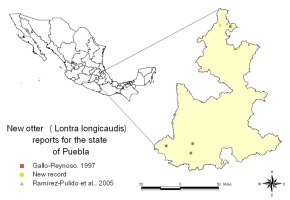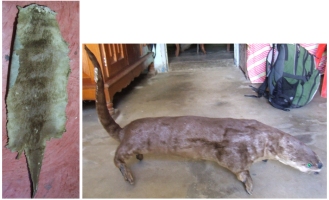IUCN/SSC Otter Specialist Group Bulletin

|
IUCN/SCC Otter Specialist Group Bulletin Volume 27 Issue 3 Pages 123- 166 (December 2010)) Citation: Ramírez-Bravo, O.E. (2010). Neotropical Otter (Lontra longicaudis) Records in Puebla, Central Mexico. IUCN Otter Spec. Group Bull. 27 (3): 134 - 136 Neotropical Otter (Lontra longicaudis) Records in Puebla, Central Mexico Osvaldo Eric Ramírez-Bravo1, 2
1
Departamento de Ciencias Químico-Biológicas, Universidad de las Américas, Puebla, Santa Catarina Mártir, Sin Número, Cholula, Puebla. e-mail: ermex02@yahoo.com
|

|
|
Abstract: This study, presents new historical and actual reports of neotropical otter (Lontra longicaudis) confirming its presence in the Sierra Norte, state of Puebla, Mexico. |
| Keywords: Lontra longicaudis, Mustelid, Puebla, Sierra Norte, Otter |
| Française | Español |
The neotropical otter (Lontra longicaudis) is a neotropical mustelid that can be found along fresh water rivers from Northern Mexico to Uruguay however; there is little information on this species (Macías-Sánchez and Aranda, 1999). In Mexico it is considered as the most widespread and better known of the three otter species present (Gallo-Reynoso, 1997); as it has been recorded in in 22 states from the 32 in Mexico (Gallo-Reynoso, 1997; López-Wilchis and López-Jardines, 1998; Ramírez-Pulido et al. 2005; Botello et al. 2006; Casariego-Mandorell et al. 2006; Gallo-Reynoso et al. 2008; Monroy-Vilchis and Mundo, 2009). The species is found in all the large and medium size rivers, as well as in coastal plain and mountain rivers (Gallo-Reynoso, 1997) from sea level to 2000 m (Botello et al. 2006). However, an increase in pollution has led to a decrease in populations along the country (Gallo-Reynoso, 1997). It is considered as a threatened species (Maldonado and Lopez Gonzalez, 2003) thus, it is important to determine its presence and distribution.
Otters presence in Puebla has been recorded previously through footprints and scats in the Mixteca area, in the south west and in the Sierra Norte in the northern part of the state (Gallo-Reynoso, 1997). The most recent record is an observation of a pup kept as a pet in the Sierra Norte in the northern part of the state however, its origin was not defined (Ramírez-Pulido et al., 2005). The aim of this note is to present three new records obtained opportunistically while conducting a field survey in August 2010, for the project “The Jaguar in Puebla: Presence and human relations” (Figure. 1). The study area is located in northern Puebla, encompassing an area of 5,709.82 km2 which include 55 municipalities. The records were obtained through interviews with hunters and tanneries in the area.

|
|
Figure 1. New records for neotropical
otter (Lontra longicaudis) for the state of Puebla (click for larger image) |
We obtained two records, consisting in the skins of two otters found in the town of Mecapalapa (20º 31´ 37” N/ 97º 51´ 20” W,) (Figure 2a), the individuals were hunted in the Pantepec River that ends in the Gulf of Mexico. One corresponds to an adult individual of undetermined sex and the other to a juvenile. The interviewed person mentioned that the adult individual was hunted more than 30 years ago and the juvenile 10 years ago but no exact dates were given. However, the same person states that the species can still be seen along the river. The other report corresponds to a stuffed individual that was photographed in the town of Tuzamapan (20º 03´ 52” N/ 97º 34´ 28” W) (Figure 2b). The otter was hunted in the Tecolutla River near the town of Reyes de Vallarta (20º 07´ 06”N/ 97º 30´ 03” W) in March 2010. The skin was bought and then stuffed by a hunter in Tuzamapan. The specimen corresponds to an adult individual of undetermined sex.

|
|
Figure 2. 2a (left) Otter skin found
in Mecapalapa, caught in the Pantepec River: 2b (right) stuffed otter hunted
in the Tecolutla River (click for larger image) |
These reports are important because they fall in the tropical mountainous area, which is considered a priority for otter conservation in Mexico (Gallo-Reynoso, 1997). However, there is no information about connectivity with other populations such as the ones found in Veracruz (Macías-Sanchez and Aranda, 1999). On the other hand, they provide direct evidence about the historical and actual presence of neotropical otter in the state of Puebla. Further development of this study will help to determine the species distribution, status and connectivity in the state.
Acknowledgements - I would like to thank Panthera Foundation who supported us with a grant for the project: “The Jaguar in the state of Puebla, Central Mexico: Presence, Conservation and Human Relations”, to Universidad de las Americas for the facilities provided.
REFERENCES
REFERENCES
Botello, F., Salazar, J.M., Illoldi Rangel, P., Linaje, M.,
Monroy, G., Duque, D., Sánchez Cordero, V. (2006). Primer
registro de la nutria neotropical de río (Lontra longicaudis)
en la Reserva de la Biosfera de Tehuacán-Cuicatlán,
Oaxaca, México. Revista Mexicana de Biodiversidad. 77:
133-135.
Casariego-Mandorell, M.A., List, R., Ceballos, G. (2006). Aspectos
básicos sobre la ecología de la nutria de río
(Lontra longicaudis annectens), para la costa de Oaxaca. Revista
Mexicana de Mastozoología. 10: 71-74.
Gallo-Reynoso, J.P. (1997). Situación y distribución
de las nutrias en México, con énfasis en Lontra longicaudis
annectens MAJOR, 1897. Revista Mexicana de Mastozoología. 2:
10 -32
Gallo-Reynoso, J.P., Ramos-Rosas N.N., and Rangel Aguilar,
O. (2008). Depredación de aves acuáticas por
la nutria neotropical (Lontra longicaudis annectens), en el
río Yaqui, Sonora, México. Revista Mexicana de Biodiversidad. 79:
275-279.
López-Wilchis, R., López Jardines J. (1998). Los
mamíferos de México depositados en colecciones de Estados
Unidos y Canada. Universidad Autónoma Metropolitana. Unidad
Iztapalapa. México
Maldonado, J.R.E., López González, C.A. (2003). Recent
records for the neotropical river otter (Lontra longicaudis) in Guerrero,
Mexico. IUCN Otter Spec. Group Bull. 20: 9-11.
Macías-Sánchez, S., Aranda, M. (1999). Análisis
de la alimentación de la nutria Lontra longicaudis (Mammalia:
Carnivora) en un sector del Río Pescados, Veracruz, México.
Acta Zoológica Mexicana. 79: 49- 57.
Monroy-Vilchis, O. y Mundo V. (2009). Nicho trófico
de la nutria neotropical (Lontra longicaudis) en un ambiente
modificado, Temascaltepec, México. Revista Mexicana de Biodiversidad. 80:
801-806.
Ramírez Pulido, J., González-Ruiz, N., Genoways
H.H. (2005). Carnivores from the Mexican State of Puebla:
Distribution, Taxonomy and Conservation. Mastozoología Neotropical, 12:
37-52.
Résumé : Données
de Loutres à Longue Queue (Lontra longicaudis) dansl’État
de
Puebla, Centre Mexique
Cette étude présente les données historiques récentes
ainsi que les travaux actuels sur la Loutre à longue queue (Lontra
longicaudis) confirmant ainsi sa présence en Sierra du Nord dans
l’état de Puebla, Mexique.
Revenez au dessus
Resumen: Reportes De Nutria (Lontra
longicaudis) En Puebla, Mexico
En este estudio, se presentan nuevos reportes históricos
y actuales de nutria neotropical (Lontra longicaudis) confirmando
la presencia de la especie en la Sierra Norte de Puebla, México.
Vuelva a la tapa